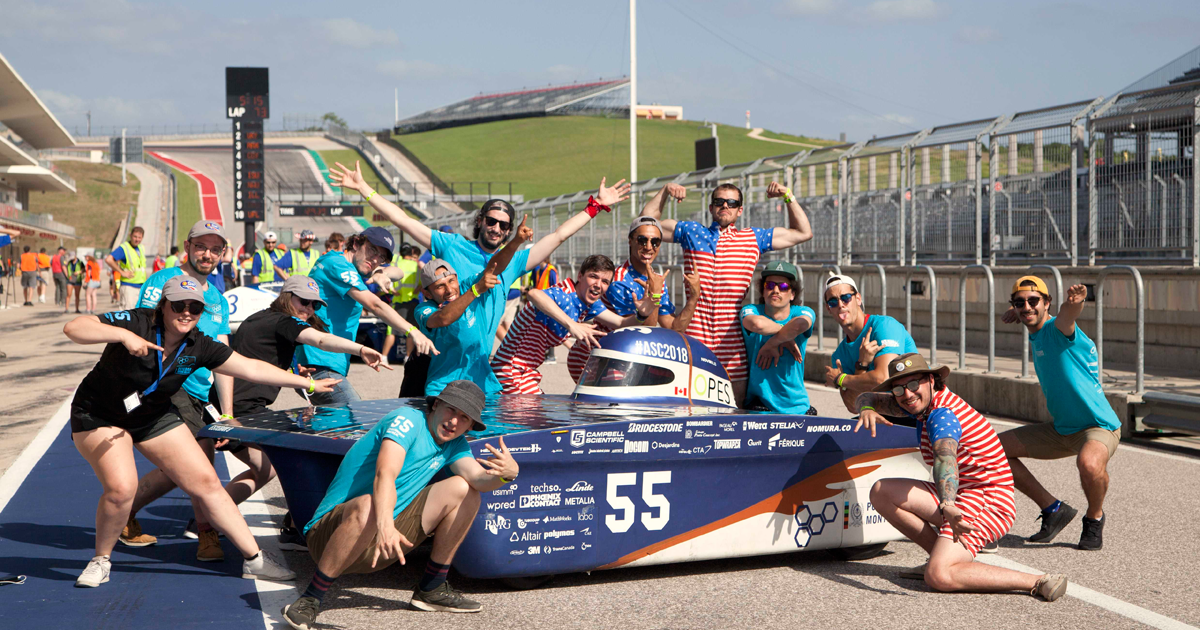Nouvelles
Esteban Project solar car wins big at the 2019 Formula Sun Grand Prix competition in the U.S.
Piloting their prototype solar car Esteban 9, the Polytechnique student technical society team won the race on the American Solar Challenge closed course for the second year running, also setting a record and taking home the Teamwork Award.

The Esteban Project technical society delegation with the Esteban 9 prototype, at the 2019 Formula Sun Grand Prix competition in Texas. (Photo: Esteban Project)
At the competition, presented by the Innovators Educational Foundation from July 1 to 6, 2019, Esteban 9 completed 230 laps of the Circuit of The Americas racetrack in Austin, Texas, over three days, covering a total cumulative distance of 788 miles, or 1,268 kilometres.
The Polytechnique technical society finished ahead of a team from Principia College in Illinois, with 195 laps completed, and another from the University of Kentucky, with 153 laps completed. Ten teams out of the 12 originally registered took part in the Single-Occupant Vehicle category of the competition.
With this performance, the Esteban Project also set a new Formula Sun Grand Prix course record for total laps on the Circuit of The Americas track. The previous standard of 228 laps had been established in 2017.
“It was a fun experience and all the team members really enjoyed it,” says Philippe Turcotte, director of the Esteban Project and an undergraduate student in electrical engineering. “We had a good vehicle and we knew what we were capable of. That said, it took a lot of focus on our part to stay on course right till the end, avoid any mechanical failures, and come out on top. We’re really stoked; we couldn’t have hoped for a better result!”
A pole-to-pole victory
The Esteban Project performed strongly right from the start, becoming the first team entered to complete all of the steps in the inspection process, which is the qualifying stage of the Formula Sun Grand Prix. That result ensured that the technical society would start the endurance race from the pole position, slightly ahead of the other entrants.
“Our goal was to finish first in qualifying so we’d be first off the starting grid,” Mr. Turcotte explains. “There’s a steep slope at the start of the course, which a lot of teams have trouble climbing, and we knew we were able to get up it. That gave us a good lead, because we didn’t get stuck going up the slope. We started piling up the laps, and we never relinquished our lead for the rest of the race.”
At the end of the first day of competition, July 4, the Esteban Project was at the top of the leaderboard with 81 laps completed in 8 hours, 5 minutes, and 29 seconds, for a total distance covered of 277.8 miles (mi), or 447.07 kilometres (km), at an average speed of 34.36 miles per hour (mph), or 55.3 kilometres per hour (km/h).
The next day, the Polytechnique team held on to first place, completing 79 laps in 8 h 6 min, the highest total of the day, for a total distance of 271.02 mi (436.16 km) at an average speed of 33.47 mph (53.86 km/h).
On the third and final day of the competition, Esteban 9 finished atop the daily leaderboard (and the cumulative rankings), having completed 73 laps in 8 h 13 min 55 sec, for a total distance of 250.44 mi (403.04 km) at an average speed of 31.77 mph (51.13 km/h).
This marked the Esteban Project’s second win in as many years in the Single-Occupant Vehicle category at the annual Formula Sun Grand Prix. In 2018, the technical society had finished first overall on the Motorsports Park Hastings course in Hastings, Nebraska (where the closed-course race takes place every other year, alternating with the Circuit of The Americas), after its Esteban 9 prototype completed 403 laps. In so doing, the Esteban Project had qualified for the American Solar Challenge competition, a rally across four U.S. states. The Polytechnique delegation finished fourth in that race and took home engineering awards at the competition, which is held every two years.
“We used the same vehicle as in last year’s competitions, with a few minor tweaks, because a prototype is built to last over two years of competition. There was no wear and tear and it was just as reliable as on its first day of racing,” Mr. Turcotte notes. “Esteban 9 is going into retirement on a high note! The vehicle was designed for on-track competitions, so we’re proud to have won the events where we were aiming for a win.”
Teamwork Award
The Esteban Project also received the Teamwork Award from the 2019 Formula Sun Grand Prix competition organizers.
“This award is presented to the group that shows the best team spirit, that’s the most well organized, and that shows cohesion. It’s nice to have, as we weren’t expecting to win it this year,” Mr. Turcotte says.
“It’s true that we put a lot of work in to make sure the entire team felt supported and the members had fun being part of the event: you could see the chemistry was right, the tasks were well distributed, and everyone was in sync. We showed great sportsmanship; it was great to see!” he concludes, noting that the techical society members represent nearly every field of engineering.
With the 2019 competition season now over, the Esteban Project team will soon begin the process of designing and manufacturing its next prototype solar vehicle, Esteban 10, to be unveiled in April 2020.
Kudos to all the members of the Esteban Project!
To learn more
Esteban Project website
American Solar Challenge website
Innovators Educational Foundation website




